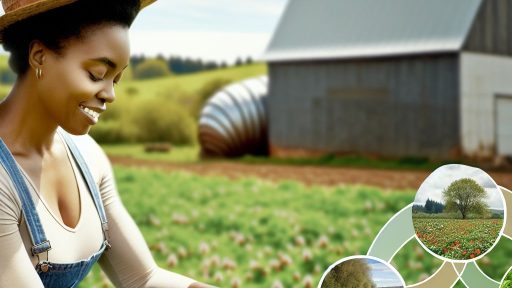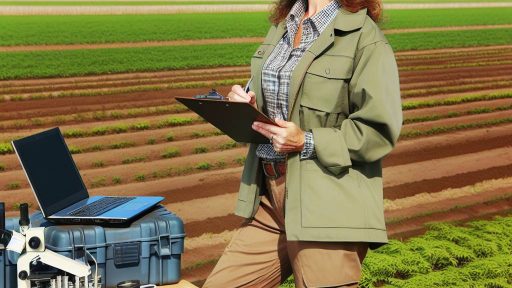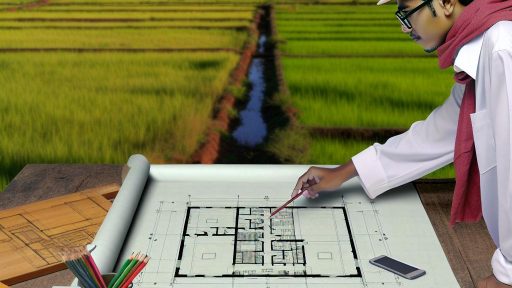Understanding Soil Erosion: Causes and Impacts on Waterfront and Hillside Properties
Defining Soil Erosion
Soil erosion is the process of soil being removed from its original location.
This process can occur due to water, wind, or human activity.
Understanding soil erosion is essential for property protection.
Causes of Soil Erosion
Several factors contribute to soil erosion on properties.
Water runoff, especially during storms, is a significant factor.
Additionally, strong winds can carry loose soil particles away.
Land use practices, such as construction and deforestation, worsen the problem.
Agricultural activities can also lead to increased soil disturbance.
Natural Causes
Heavy rainfall can saturate the soil and trigger erosion.
Stream bank erosion is a natural process along waterways.
Wildfires can remove vegetation, reducing soil stability.
Human-Induced Causes
Construction sites often expose bare soil to erosion.
Deforestation eliminates roots that hold soil in place.
Improper agricultural practices can lead to soil degradation.
Impacts of Soil Erosion
Soil erosion can have severe consequences for properties.
Transform Your Agribusiness
Unlock your farm's potential with expert advice tailored to your needs. Get actionable steps that drive real results.
Get StartedIt leads to loss of fertile topsoil, affecting plant growth.
This degradation can decrease property value over time.
Water quality in nearby lakes and rivers may degrade as well.
Erosion can cause sedimentation, impacting aquatic ecosystems.
Impact on Waterfront Properties
Waterfront properties are especially vulnerable to erosion.
Erosion can undermine land near water bodies, threatening structures.
This results in costly repairs and potential property loss.
Impact on Hillside Properties
Hillside properties face risks from gravity and excessive rainfall.
Soil slips can jeopardize buildings and roadways.
This erosion can cause landslides, creating dangerous conditions.
Mitigating Erosion
Implementing effective erosion control strategies is vital.
Landowners can adopt various practices to protect their properties.
Stabilizing soil helps maintain the integrity of waterfront and hillside areas.
Key Differences in Erosion Types: Water vs. Wind Erosion in Sloped Landscapes
Understanding Water Erosion
Water erosion occurs mainly through rainfall and runoff.
This type of erosion is especially prevalent in sloped landscapes.
It can lead to significant soil displacement and degradation.
Rainfall intensity and duration greatly influence water erosion rates.
Additionally, the slope’s steepness affects runoff speed and sediment transport.
Types of Water Erosion
There are several forms of water erosion to consider.
- Sheet erosion: Thin layers of soil wash off evenly across a large area.
- Rill erosion: Small channels form in the soil due to concentrated flow.
- Gully erosion: Larger channels create significant landscape changes.
Understanding Wind Erosion
Wind erosion occurs primarily in dry, loose soils.
This type of erosion is especially harmful in arid regions.
Wind can detach and transport soil particles over great distances.
Consequently, it leads to land degradation and reduced fertility.
Factors Influencing Wind Erosion
Several factors affect wind erosion rates.
Showcase Your Farming Business
Publish your professional farming services profile on our blog for a one-time fee of $200 and reach a dedicated audience of farmers and agribusiness owners.
Publish Your Profile- Soil texture: Fine-textured soils are more susceptible to wind erosion.
- Vegetative cover: Areas with less cover experience higher erosion rates.
- Wind speed and direction: Strong winds can exacerbate the erosion process.
Comparing Water and Wind Erosion
Both water and wind erosion pose significant risks to landscapes.
However, their mechanisms of action differ considerably.
Water erosion primarily occurs through liquid movement, while wind erosion relies on gas movement.
Moreover, water erosion typically results in visible channel formations.
In contrast, wind erosion can lead to dust storms and sandy landscapes.
Implementing Control Measures
Effective control measures can significantly reduce both types of erosion.
For water erosion, planting vegetation can stabilize soil and absorb water.
Furthermore, constructing terraces can slow down water flow.
For wind erosion, maintaining ground cover with grasses or plants is essential.
Additionally, using windbreaks can help reduce wind velocity across vulnerable areas.
Vegetative Solutions: How Planting Trees and Shrubs Can Stabilize Soil
Introduction to Vegetative Solutions
Vegetative solutions leverage natural processes to combat soil erosion.
Planting trees and shrubs plays a crucial role in stabilizing soil.
These plants enhance soil integrity while offering additional benefits.
Benefits of Planting Trees
Trees provide a robust root system that holds soil in place.
They absorb water, reducing runoff and erosion during heavy rains.
Additionally, trees contribute to improved air quality and biodiversity.
Choosing the Right Shrubs
Choosing the right shrubs is essential for effective soil stabilization.
Consider native species, as they adapt well to local conditions.
Low-growing shrubs can prevent soil from washing away on slopes.
Planting Techniques
Proper planting techniques maximize the benefits of trees and shrubs.
Start by digging appropriate holes that accommodate root systems.
Ensure plants have sufficient space to grow and thrive.
Water newly planted vegetation regularly to help establish roots.
Maintenance Practices
Regular maintenance enhances the effectiveness of vegetative solutions.
Pruning helps maintain healthy growth and prevents overcrowding.
Monitor for pests and diseases to keep plants resilient.
Add mulch around plants to retain moisture and reduce weed competition.
Combining Vegetative Solutions with Other Techniques
Vegetative solutions work best when combined with other erosion control methods.
Consider using terracing on steep slopes for additional support.
Utilizing erosion control blankets can provide immediate soil coverage.
As a result, these strategies create a multifaceted approach to erosion control.
Delve into the Subject: Drought Preparedness Plans for Farmland Investors and Property Owners
Engineered Structures: Utilizing Retaining Walls and Terracing for Erosion Control
Importance of Erosion Control
Erosion impacts soil health and property stability.
Managing erosion helps maintain landscape integrity.
Effective strategies can mitigate damage from heavy rains.
To achieve this, engineered structures are key.
Retaining Walls: Function and Benefits
Retaining walls provide structural support against soil movement.
They help create level areas, reducing runoff during storms.
Moreover, these walls can enhance landscape aesthetics.
Common materials include concrete, stone, and timber.
Showcase Your Farming Business
Publish your professional farming services profile on our blog for a one-time fee of $200 and reach a dedicated audience of farmers and agribusiness owners.
Publish Your ProfileEach material offers unique benefits and challenges.
Design Considerations
Proper design increases the longevity of retaining walls.
Ensure drainage systems are integrated to prevent pressure buildup.
Additionally, consider wall height and slope stability.
Consulting with professionals is advisable for complex projects.
Terracing: An Alternative Solution
Terracing involves creating flat areas on slopes.
This method reduces soil erosion significantly.
It also enhances water retention in soil.
Terraces can be constructed using soil, stone, or concrete.
Each option varies in cost and environmental impact.
Implementation and Maintenance
Successful terracing requires careful planning and execution.
Regular maintenance is necessary for effective performance.
Make sure to check for any signs of erosion periodically.
Timely repairs can save costly restorations later.
Involve local experts for optimal long-term outcomes.
You Might Also Like: Key Soil Health Factors to Assess Before Buying Agricultural Land
Natural Barriers
The Role of Buffers
Buffers serve as protective zones against soil erosion.
These areas absorb excess water and reduce runoff.
They filter pollutants before they reach open water.
Incorporating native vegetation enhances buffer effectiveness.
Plant roots stabilize soil, reducing displacement.
Additionally, buffers provide habitats for local wildlife.
Understanding Riparian Zones
Riparian zones are the interfaces between land and water bodies.
They play a critical role in controlling erosion.
These areas support diverse plant and animal life.
Riparian vegetation improves water quality significantly.
Moreover, they act as natural barriers during floods.
Maintaining riparian zones ensures ecosystem balance.
Strategies for Implementing Buffers and Riparian Zones
Designing effective buffers requires site-specific knowledge.
First, conduct a soil analysis to determine suitability.
Next, select native plant species that thrive locally.
Moreover, consider the hydrology of the area for best results.
Regular maintenance ensures the longevity of these systems.
Additionally, community involvement fosters local stewardship.
Examples of Effective Practices
- Planting dense shrubs and trees to slow water flow.
- Creating wetlands for natural filtration of runoff.
- Utilizing contour planting to follow land contours.
These practices enhance both soil health and water quality.
Ultimately, the collective benefits contribute to sustainable property management.
See Related Content: Water Conservation Techniques for Sustainable Farm Real Estate Growth

Soil Conservation Techniques
Cover Crops
Cover crops play a vital role in preventing soil erosion.
They act as a protective layer over the soil surface.
These crops enhance soil structure and fertility.
Showcase Your Farming Business
Publish your professional farming services profile on our blog for a one-time fee of $200 and reach a dedicated audience of farmers and agribusiness owners.
Publish Your ProfileMoreover, they promote water retention in the soil.
Planting legumes, such as clover or vetch, improves nitrogen levels.
In addition, cover crops suppress weeds effectively.
This strategy reduces the need for chemical herbicides.
Farmers can select species suited for their local climate.
This choice increases the chances of successful growth.
Mulching
Mulching is another effective soil conservation method.
It involves applying a protective layer over the soil.
This layer can be comprised of organic or inorganic materials.
Organic options include straw, wood chips, or grass clippings.
Inorganic choices could be rocks or plastic sheeting.
Mulching helps retain moisture during dry periods.
Additionally, it prevents temperature fluctuations in the soil.
The use of mulch significantly reduces soil erosion.
It also improves soil health by promoting microbial activity.
Implementing These Strategies
To maximize benefits, farmers should rotate cover crops regularly.
This practice enhances soil nutrient cycling.
Additionally, integrating mulching with cover crops is beneficial.
This combination can drastically improve soil conservation.
Moreover, consistent monitoring ensures effectiveness of these techniques.
Engaging with local agricultural experts can provide tailored solutions.
Lastly, educating community members promotes broader adoption.
Collectively, these actions lead to healthier ecosystems.
Uncover the Details: Why Sustainable Irrigation Is Essential for Long-Term Land Investment
Water Management Practices
Importance of Drainage Systems
Effective drainage systems reduce erosion risk significantly.
They help manage water flow and minimize soil disturbance.
Additionally, proper drainage improves soil health and stability.
Types of Drainage Systems
- Surface drainage systems help remove excess water from the soil surface.
- Subsurface drainage systems direct water away from root zones.
- Swales can channel water effectively across a landscape.
- French drains are useful for redirecting groundwater.
Implementing a Drainage Plan
Begin by assessing the specific needs of your property.
Evaluate soil type and topography to determine the best solutions.
Consult with professionals for tailored drainage strategies.
Moreover, ensure all systems comply with local regulations.
Maintenance of Drainage Systems
Regular maintenance is crucial for effective drainage.
Inspect systems for blockages and damage periodically.
Clear debris from drains and channels to maintain flow.
Also, monitor changes in soil conditions and water flow.
Community Involvement
Importance of Education
Educating neighbors on erosion prevention is crucial.
Knowledge increases community awareness about erosion’s impact.
Awareness fosters collective action against soil erosion.
Engaging Local Stakeholders
Involve local environmental groups in erosion discussions.
They can provide valuable insights and resources.
Showcase Your Farming Business
Publish your professional farming services profile on our blog for a one-time fee of $200 and reach a dedicated audience of farmers and agribusiness owners.
Publish Your ProfileCollaboration strengthens community bonds and efforts.
Organizing Workshops
Hosting workshops can promote effective erosion control strategies.
Invite experts to share their knowledge on soil management.
Hands-on activities can demonstrate practical erosion prevention techniques.
Creating Informative Materials
Develop brochures that outline erosion prevention tips.
Distribute these materials through local businesses and community centers.
Utilize social media to spread awareness about erosion control.
Building a Support Network
Establish a neighborhood alliance focused on soil preservation.
Encourage members to share erosion prevention experiences.
Support networks can also help monitor erosion issues.
Promoting Local Initiatives
Encourage community-led cleanup events along waterfront areas.
Organize tree planting days to stabilize soil.
Local initiatives foster community ownership and responsibility.




